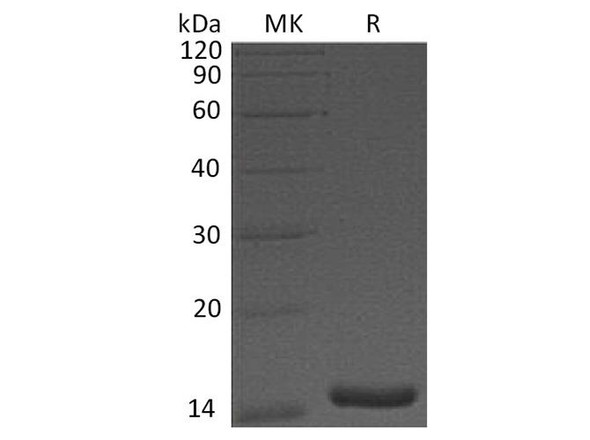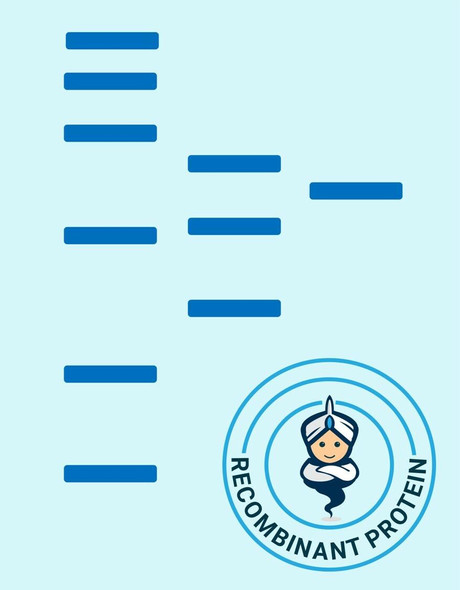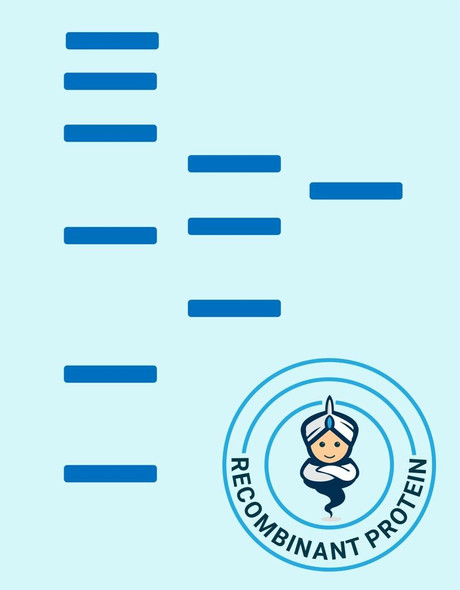Description
| Product Name: | Human CST3 Recombinant Protein |
| Product Code: | RPPB3432 |
| Size: | 100µg |
| Species: | Human |
| Target: | CST3 |
| Synonyms: | Cystatin-C, Cystatin-3, Neuroendocrine basic polypeptide, Gamma-trace, Post-gamma-globulin, CST3, MGC117328. |
| Source: | Human urine |
| Physical Appearance: | Sterile Filtered White lyophilized (freeze-dried) powder. |
| Formulation: | Lyophilized from 0.02M NH4HCO3. May contain traces of buffer salts. |
| Solubility: | Use of a 0.02M NH4HCO3 buffer is recommended. |
| Stability: | Human Cystatin-C although stable at 4°C for 1 week, should be stored at -15°C.Please avoid freeze-thaw cycles. |
| Purity: | Greater than 96% as determined by SDS PAGE. |
Cystatins are a superfamily of cysteine proteinase inhibitors found in both plants and animals. They comprise a group of proteinase inhibitors, widely distributed in tissues and body fluids, and form tight complexes with cysteine proteases such as cathepsin B, H, L and S. Cystatin C, a secreted molecule of this family, is of interest from biochemical, medicine and evolutionary points of view. Cystatin C, with molecular weight of 13260 Da, is composed of 120 amino acids, lacks carbohydrate and has two disulfide bridges located near the carboxyl terminus. Cystatin C is increased in patients with malignant diseases, and is related to the insufficiency of renal function and appears to be a better marker than creatinine. On the other hand, low levels of cystatin C involve cause the breakdown of the elastic laminae and, subsequently, the atherosclerosis and abdominal aortic aneurysm.
| UniProt Protein Function: | CST3: As an inhibitor of cysteine proteinases, this protein is thought to serve an important physiological role as a local regulator of this enzyme activity. Defects in CST3 are the cause of amyloidosis type 6 (AMYL6); also known as hereditary cerebral hemorrhage with amyloidosis (HCHWA), cerebral amyloid angiopathy (CAA) or cerebroarterial amyloidosis Icelandic type. AMYL6 is a hereditary generalized amyloidosis due to cystatin C amyloid deposition. Cystatin C amyloid accumulates in the walls of arteries, arterioles, and sometimes capillaries and veins of the brain, and in various organs including lymphoid tissue, spleen, salivary glands, and seminal vesicles. Amyloid deposition in the cerebral vessels results in cerebral amyloid angiopathy, cerebral hemorrhage and premature stroke. Cystatin C levels in the cerebrospinal fluid are abnormally low. Genetic variations in CST3 are associated with age- related macular degeneration type 11 (ARMD11). ARMD is a multifactorial eye disease and the most common cause of irreversible vision loss in the developed world. In most patients, the disease is manifest as ophthalmoscopically visible yellowish accumulations of protein and lipid that lie beneath the retinal pigment epithelium and within an elastin-containing structure known as Bruch membrane. Belongs to the cystatin family. |
| UniProt Protein Details: | Protein type:Secreted, signal peptide; Inhibitor; Secreted Chromosomal Location of Human Ortholog: 20p11.21 Cellular Component: extracellular space; extracellular region Molecular Function:protein binding; protease binding; beta-amyloid binding; endopeptidase inhibitor activity; cysteine protease inhibitor activity Biological Process: negative regulation of proteolysis; fibril organization and biogenesis; negative regulation of peptidase activity; defense response; regulation of tissue remodeling Disease: Macular Degeneration, Age-related, 11; Cerebral Amyloid Angiopathy, Cst3-related |
| NCBI Summary: | The cystatin superfamily encompasses proteins that contain multiple cystatin-like sequences. Some of the members are active cysteine protease inhibitors, while others have lost or perhaps never acquired this inhibitory activity. There are three inhibitory families in the superfamily, including the type 1 cystatins (stefins), type 2 cystatins and the kininogens. The type 2 cystatin proteins are a class of cysteine proteinase inhibitors found in a variety of human fluids and secretions, where they appear to provide protective functions. The cystatin locus on chromosome 20 contains the majority of the type 2 cystatin genes and pseudogenes. This gene is located in the cystatin locus and encodes the most abundant extracellular inhibitor of cysteine proteases, which is found in high concentrations in biological fluids and is expressed in virtually all organs of the body. A mutation in this gene has been associated with amyloid angiopathy. Expression of this protein in vascular wall smooth muscle cells is severely reduced in both atherosclerotic and aneurysmal aortic lesions, establishing its role in vascular disease. In addition, this protein has been shown to have an antimicrobial function, inhibiting the replication of herpes simplex virus. Alternative splicing results in multiple transcript variants encoding a single protein. [provided by RefSeq, Nov 2014] |
| UniProt Code: | P01034 |
| NCBI GenInfo Identifier: | 118183 |
| NCBI Gene ID: | 1471 |
| NCBI Accession: | P01034.1 |
| UniProt Related Accession: | P01034 |
| Molecular Weight: | |
| NCBI Full Name: | Cystatin-C |
| NCBI Synonym Full Names: | cystatin C |
| NCBI Official Symbol: | CST3�� |
| NCBI Official Synonym Symbols: | ARMD11; HEL-S-2�� |
| NCBI Protein Information: | cystatin-C |
| UniProt Protein Name: | Cystatin-C |
| UniProt Synonym Protein Names: | Cystatin-3; Gamma-trace; Neuroendocrine basic polypeptide; Post-gamma-globulin |
| Protein Family: | Cystatin |
| UniProt Gene Name: | CST3�� |
| UniProt Entry Name: | CYTC_HUMAN |










